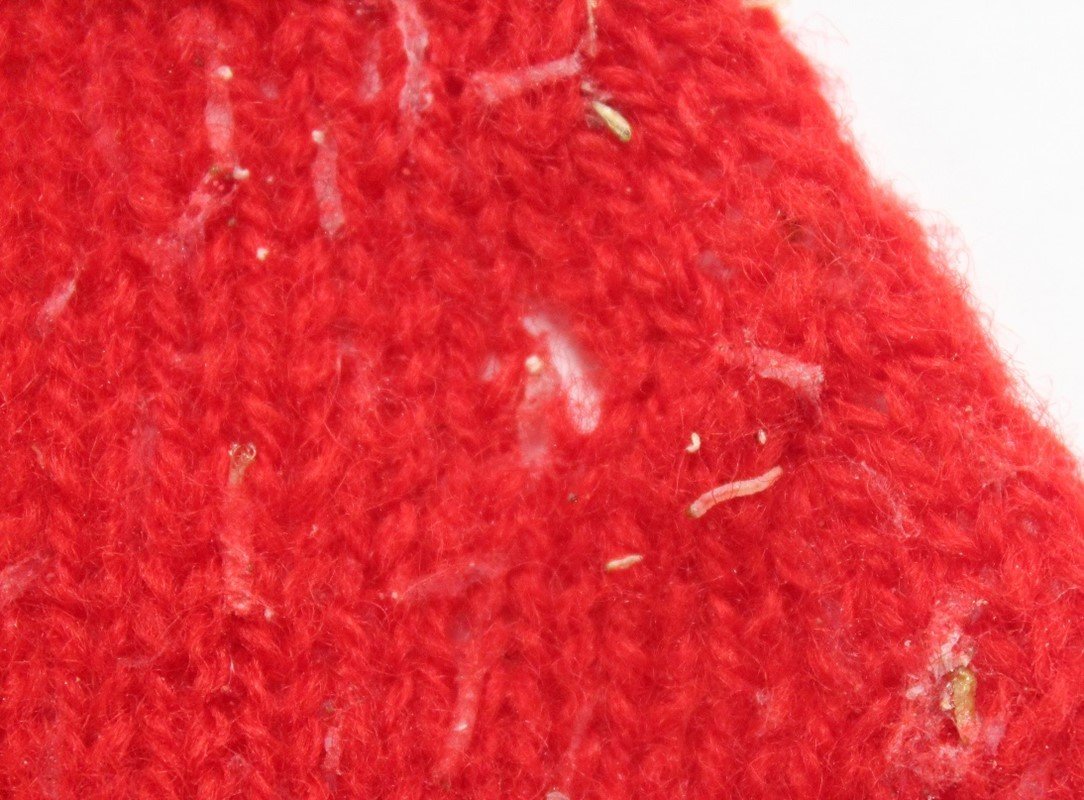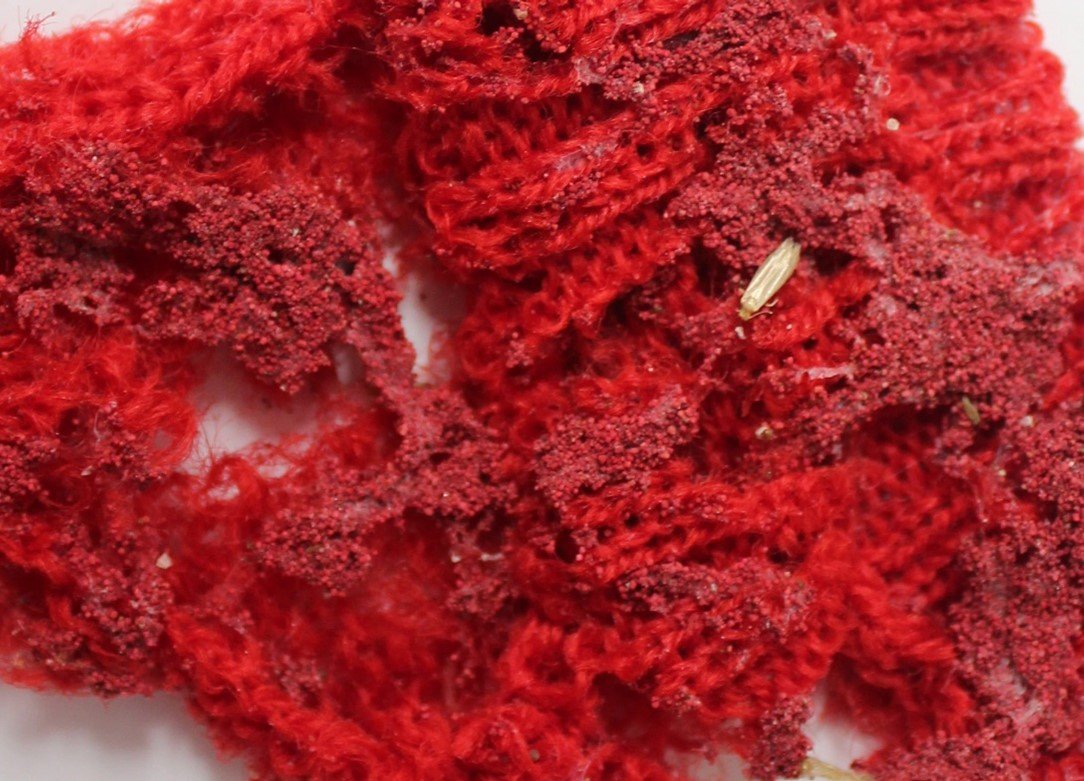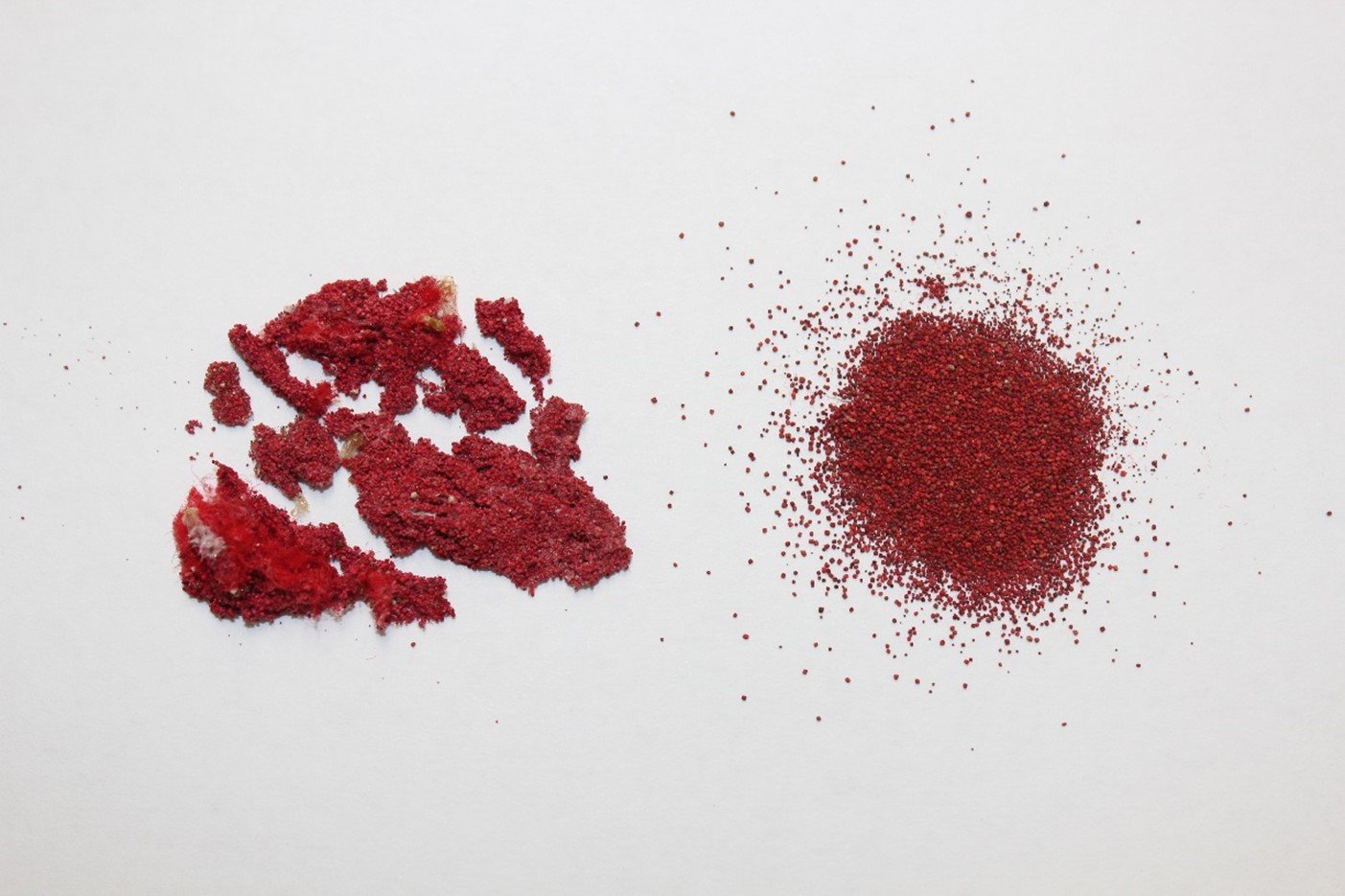Identifying Clothes Moth Damage and Frass
By Patrick Kelley, BCE
It has been many months since you wore that favorite red sweater of yours, but now that the cooler temperatures have started to creep in you immediately go to look for it in your closet. As you pull it from the shelf, you notice a dirty spot around the collar. Extending it away from you, you now see gaping holes in several areas that were not there before. You scream to yourself, “What Caused This?!”.
It is likely that your mind jumps to the conclusion that you have clothes moths, but how can you tell for sure? The first part of this two-part article will lay out what signs to look for that suggest that your damage was caused by clothes moths compared to mechanical damage, damage by carpet beetles or by other means. Part 2 will detail what the appearance of the frass looks like for the webbing clothes moth as opposed to the casemaking clothes moth, and how moth frass may appear different than carpet beetle frass.
Webbing clothes moth damage on wool will present itself as silken tubes as seen in the photo (left) or as frass-covered feeding tubes as seen on the photo (right). Occasionally, you might also find cream colored larvae and live and dead adult moths. Photo by E. Estabrook, Insects Limited, Inc.
Part 1: Clothes Moth Damage
When you first notice a hole in a sweater or other clothing, the first thing that you should examine is how clean or dirty the area around the hole is. Using a good magnifying glass to closely inspect the area around the hole will make it easier to see some of the details.
Insect Damage: When insects cause damage, they will almost always leave clues of their presence. When it is clothes moths causing the damage, these clues will be in the form of dirty frass (insect excrement), wisps of silk webbing, feeding tubes, and pupal cases. When the damage is caused by carpet (Dermestid) beetles, the clues will be frass pellets and numerous
larval shed skins near the damage. Holes caused by insects feeding on wool will often have a slightly depressed area surrounding the hole where the insect has grazed on the surface of the textile but not all the way through.
Mechanical Damage: If there is no dirt or frass surrounding the hole and the item has not been recently cleaned, there is a good chance that the damage was caused by another means. Mechanically caused holes can form when sharp metal edges on desks, tables, or in other work areas snag and cut the fabric as we walk past or lean against these surfaces. If you find multiple articles of your clothing with damage and that damage is all in the same physical spot on the clothing (E.g. All the holes are located just below your belly button, or at the same point on your right side, etc.) and there is no evidence of insect activity around the holes, then they were likely caused by a sharp edge that you don’t even realize that you come in contact with. It could possibly even be your clothing getting caught in the seatbelt of your car day after day.
Chemical Damage: Another common cause of holes in clothing is chemicals that eat through the fabric. If chemicals, such as bleach or acidic cleaners, are accidentally splashed onto clothing or picked up on the clothing as we lean against tables or place our arms on countertops, it can cause the fabric to become brittle and break away. This can leave small or large holes in the clothing itself. Look for signs of discoloration or material that breaks away easily when you touch it.
Excessive Heat Damage: Burn holes caused by cigarette ashes or small embers from a grill or fire can burn or melt holes into clothing without us even knowing it. When this occurs, the area around the inside of the hole may appear black or melted. A simple sniff test may indicate if fire was involved.
Because cotton and synthetic materials are not a food source to clothes moths or carpet beetles, holes in these types of materials will almost always be caused by sharp edges, chemicals, or just plain wear and tear. The exception to this rule can occur when cotton or synthetic fabrics are hanging or laying directly adjacent to heavy populations of clothes moths on wool, feathers, or other natural fibers. If the cotton or synthetic materials have human perspiration or food stains on them, these can be attractive to the clothes moth larvae and small areas of damage can occur.
In this circumstance, the clothes moth larvae are looking for nutrients in the stains such as salt or food nutrients. Cotton and synthetic fabrics are not a food source for insects and the damage should be minimal.
A close examination of a hole in a sweater reveals a cylindrical pupal case and loose frass indicating that casemaking clothes moth, Tinea pellionella caused this damage. Photo by P. Kelley, Insects Limited, Inc.
Webbing Clothes Moth Frass Casemaking Clothes Moth Frass In the photo above, the clumpy, frass-covered feeding tubes and pupal cases on the left indicate webbing clothes moth, Tineola bisselliella damage, and the cylindrical pupal cases and loose frass on the right indicate casemaking clothes moth, TTinea pellionella damage. Photo BBy E. Estabrook, Insects Limited, Inc.
Part 2: Clothes Moth Frass
Definition from the Oxford Dictionary: /fras/ noun, mid 19th century: from German Frass, from fressen ‘devour’. = the excrement of insect larvae.
Once we have narrowed down the cause of the damage done to our clothing to be from insects, it can be beneficial to know which species you are dealing with so you will have a better understanding of your enemy. Knowing the exact species that you are dealing with will give you valuable information to battle this pest. This information includes things such as the length of the life cycle, preferred temperatures and humidity of the insect, preferential food sources, and it will guide you on which pheromone lure you will want to use to monitor for this pest. Frass, by its definition of being excrement of the insect larvae, will often be close in color to the clothing that is the insect’s food source. So, as the examples of a red wool sweater show in the pictures above and below, the frass from the larvae feeding on that sweater will also be red in color.
Webbing Clothes Moth Frass Casemaking Clothes Moth Frass Webbing clothes moth frass will be held together by silken threads and will appear lumpy and dirty as seen in the photo on the left. Casemaking clothes moth frass will be loose and granular and will easily fall away from the clothing as seen in the frass on the right of the photo above. Photo by E. Estabrook, Insects Limited, Inc.
Webbing Clothes Moth Frass
The frass from the webbing clothes moth, Tineola bisselliella, and the casemaking clothes moth, Tinea pellionella, are different in appearance. The webbing clothes moth frass is bound together by silk fibers produced by the moth larvae as they feed, whereas the casemaking frass is comprised of relatively loose fecal pellets that do not stick together. The webbing clothes moth will create lumpy-looking feeding tunnels covered in their frass, and their pupal cases will also be covered in the peppery-looking frass.
Casemaking Clothes Moth Frass
The casemaking clothes moth will simply drop their frass on the surface of the wool, and the frass will easily fall away if that item is picked up and moved. The casemaking larvae will always carry their protective cylindrical case with them. The pupal case is usually the same color as the fabric they are feeding on. As the larvae feed with their head poking out one side of the case, they will force their fecal pellets out of the other side. The pellets (or frass) will fall onto the surface of the clothing and sit there until gravity knocks them away.
Carpet Beetle Frass
In contrast to the clothes moths, if carpet beetles are causing the damage, we will almost always find the telltale empty shed skins form the larvae on the clothing or directly adjacent to the clothing. Some dermestid beetles will shed their skins up to 20 times as a larva feeds and grows prior to them pupating.
These empty husks that the larvae leave behind are very light in weight and can be blown away with a small poof of air. The frass itself of carpet beetles can vary in size and shape depending on the species. Some, like the varied carpet beetle, Anthrenus verbasci, will have oval or rounded frass while other species of dermestid beetle will have a peppery-looking frass.
In any identification of frass that we might undertake, we need to be good detectives and look at every clue that we can see. With a bit of knowledge and a good eye, we can figure out who our enemy might be that is feeding on the wool.
Signs of dermestid beetle activity on wool will often present itself with the presence of larval shed skins. Some dermestid beetles will shed their skins up to 20 times as a larva and these skins and associated frass will alert you that carpet beetles are the ones causing the damage. Photo by P. Kelley, Insects Limited, Inc.
Closeup of dermestid beetle shed skins and peppery frass. Photo by P. Kelley, Insects Limited, Inc.
Related Insect and Pheromone Posts
Read more about insects and pheromones in these related posts:
Product of the Month - All Beetle Trap Kit with RTU Gel Cartridge
Insect of the Month: Cigarette Beetle (Lasioderma serricorne)
Insects Limited, an Insect Pheromone Company
Insects Limited, Inc. researches, tests, develops, manufactures and distributes pheromones and trapping systems for insects in a global marketplace. The highly qualified staff also can assist with consultation, areas of expert witness, training presentations and grant writing.
Insects Limited, Inc. specializes in a unique niche of pest control that provides mainstream products and services to protect stored food, grain, museum collections, tobacco, timber and fiber worldwide. Please take some time to view these products and services in our web store.












